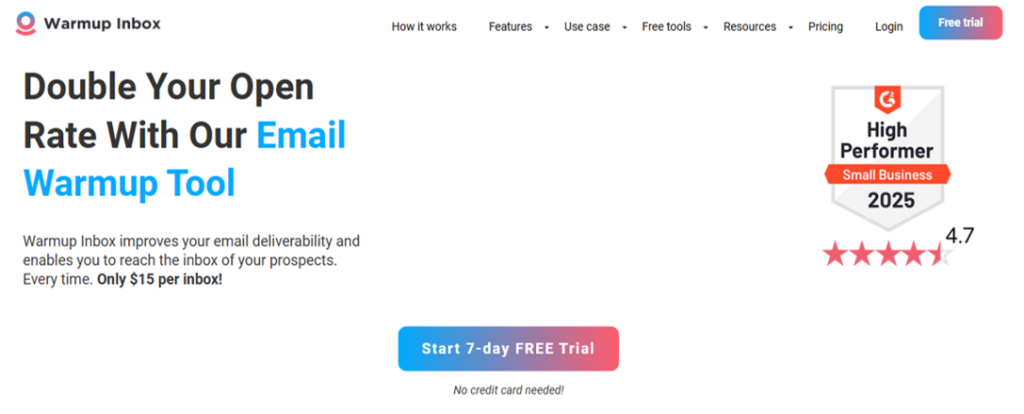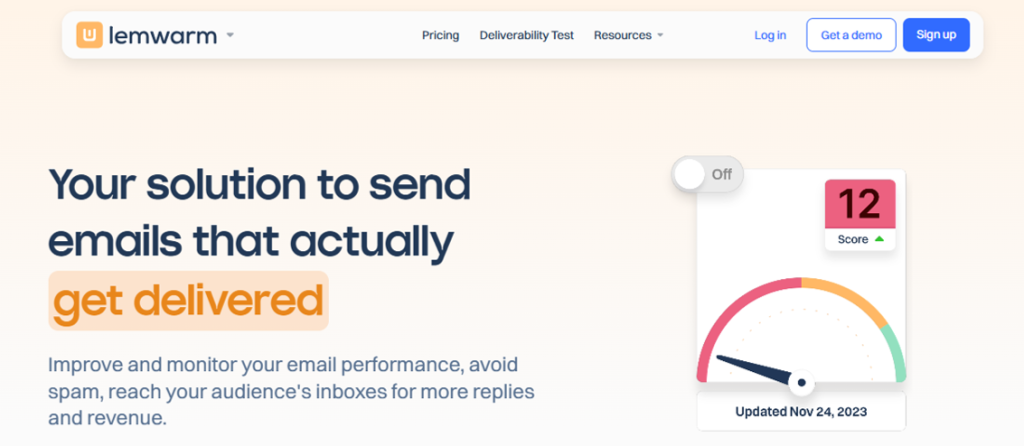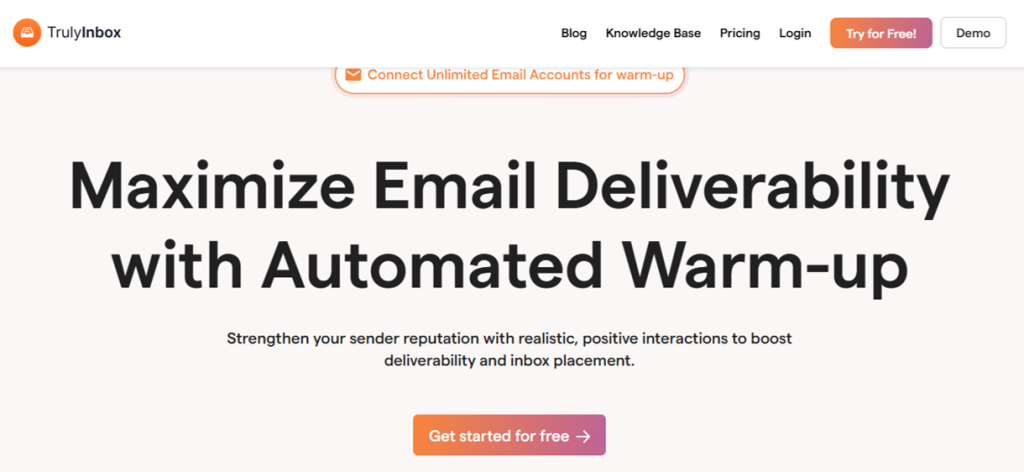- Home
- Comparing Alternatives
- Best Email Warm-Up Tools [2025 ...

Welcome to 2025! Cold email is still a mighty outreach channel, but it’s riskier than ever. Google, Microsoft, and others now run stricter spam filters, and AI scanning is standard. Even legitimate senders can get flagged as spammers.
The problem is reputation. New domains and inboxes start at zero, so blasting hundreds of emails looks suspicious. The result? Bounces, throttling, or landing in spam.
Email warm-up tools act as trust builders. They slowly increase volume, generate engagement, and show providers you’re a reliable sender. Within weeks, your inbox looks seasoned and deliverability improves.
Whether you’re a freelancer, startup, or agency, warm-up isn’t optional anymore—it’s mission-critical. Let’s explore the best email warm-up tools and how they can help your business.
What Are Email Warm-Up Tools?
See, email warm-up tools create magic. These are automation platforms that simulate human-like email activity. They don’t just send emails. The trick is that they ensure those emails receive positive engagement signals that providers watch closely.
Here’s how they work:
- Automated sending. The warm-up tool sends a small number of emails each day from your account to a network of inboxes.
- Realistic engagement. Receivers open those emails, mark as important, sometimes reply. This leads to moving them out of spam if they land there.
- Gradual scaling. The daily sending volume grows slowly over time, like five to 15 to 50 per day; your account earns a consistent and trustworthy history.
- Reputation monitoring. Warm-up platforms provide metrics like deliverability rates, spam complaints, and sender score. It will help you track progress.
These tools are like personal coaches. They “train” ESPs to treat your domain as safe and reliable, making it far easier to scale real outreach later. A proper warm-up is not a one-off hack; it offers an ongoing deliverability strategy that keeps your domain healthy.
Key Features to Look For in a Warm-Up Tool
Consider it like marathon training. Jogging a mile is easy, but real progress needs structure, tracking, and recovery. Email warm-up tools work the same way. Some only send a few emails a day, while the best in 2025 add real engagement, reputation tracking, and multi-inbox scaling.
So, when picking the best email warm-up tools in 2025, look for these features:
1. Gradual sending volume control
Here’s the thing: a proper tool won’t just send emails randomly; it will rather scale intelligently. Look for platforms that let you:
- Set a starting volume, around five to ten emails per day.
- Increase sending gradually, so providers don’t flag suspicious activity.
- Cap the maximum daily volume to align with your future outreach plans.
This helps you imitate the natural growth of a real business inbox.
2. Engagement simulation: opens, replies, and spam rescue
ESPs don’t just care about how many emails you send. They care about how recipients interact. The best warm-up tools simulate:
- Opens: Emails get opened to show engagement.
- Replies: Some messages receive short, natural-looking replies.
- Spam correction: Your email goes to spam? The tool automatically pulls it out and marks it as “not spam.”
These actions send positive reputation signals, training ESPs to trust your inbox.
3. Inbox network quality
Warm-up platforms rely on a network of real inboxes that interact with your emails. The larger and more diverse this network, the better. Go for:
- Coverage across Gmail, Outlook, Yahoo, and custom domains.
- High-volume networks: thousands of inboxes vs. just a few hundred.
- Realistic behavior: randomized open times, natural replies, and so on.
4. Deliverability analytics & reputation tracking
You don’t just want blind automation; you need visibility to ensure it’s working. Advanced tools must provide:
- Spam placement tracking.
- Domain/IP reputation scores.
- Trends over time, such as daily deliverability rates.
- Alerts, in case your domain reputation starts dropping.
They give you the chance to adjust your strategy before problems get out of hand, like a snowball.
5. Multi-inbox and team support
If you run an agency or a startup, you might need to warm up multiple inboxes at once. Look for the tools that offer:
- Multi-account dashboards.
- Centralized billing.
- Easy role-based access for team members.
6. Pricing flexibility
The warm-up process is not endless: it is a temporary phase. You will need it for the first few months of using a new domain. Don’t get stuck with an overpriced subscription you barely use. Check out these must-have features:
- Affordable entry plans.
- Flexible cancel/pause options.
- Bundled options if you also need cold email outreach software.
So, the best email warmup service combines automation, analytics, and control. This way, you will survive the warm-up period and provide a solid foundation for long-term deliverability.
Best Email Warm-Up Tools (2025 Edition)
What are the best tools for email warm-up? Here’s the list we offer to you to consider:
1. Warmup Inbox
Best for: Freelancers and small businesses seeking a straightforward, effective tool.

✨ Best features:
- Access to more than 30,000 real inboxes for realistic engagement.
- Automated open, reply, and spam-correction behaviors.
- Custom template support.
✅ Pros:
- User-friendly interface.
- A seven-day free trial is available.
- Great customer support.
⚠️ Cons:
- DNS/authentication setups only in higher tiers.
- It can get pricey when warming multiple domains.
🔍 Pricing:
- A free plan is available.
- Basic: $19/month—75 emails/day.
- Pro: $59/month—250 emails/day.
- Max: $99/month—1,000 emails/day with full features.
2. Mailwarm
Best for: Digital marketers who want simplicity with moderate warm-up needs.

✨ Best features:
- The tool sends warm-up emails and simulates engagement like opens, starred tags, and replies.
- Schedule controls: pause, resume, or adjust volume.
- Blacklist monitoring and dashboard metrics are available.
✅ Pros:
- Setup is very easy.
- The interface is clear.
⚠️ Cons:
- The Starter plan is rather expensive ($79) relative to the feature set.
- Limited functionality and network size (1,000 inboxes).
🔍 Pricing:
- Starter: $99/month (50 emails/day, one inbox).
- Growth: $189/month (200 emails/day, three inboxes plus audit).
- Scale: $549/month (500 emails/day, ten inboxes plus audit).
3. Lemwarm (by Lemlist)
Best for: Teams already using Lemlist for outreach; it is also good for integrated automation.

✨ Best features:
- Adaptive AI-driven warmup is available.
- There are real email templates for warming.
- Reputation monitoring and domain deliverability alerts are available.
✅ Pros:
- Seamless integration with Lemlist campaigns.
- Rich insights into performance and deliverability.
- Affordable entry price ($29).
⚠️ Cons:
- It is an overkill if you’re not already using Lemlist.
- Advanced features are only available at higher plans.
🔍 Pricing:
- Essential: $29/month.
- Smart: $40/month.
- Included in the Lemlist Pro tier.
4. TrulyInbox
Best for: Agencies and power users wanting deep analytics and customizable warming.

✨ Best features:
- Simulated, human-like opens, replies, and placements.
- Detailed dashboards for tracking engagement and reputation.
- Custom warm-up scheduling.
✅ Pros:
- Advanced insights.
- Tailored for multiple domains/clients.
⚠️ Cons:
- A bit higher learning curve.
- Prices may be steep for solo users.
🔍 Pricing:
The Starter plan is $29/month; the most advanced is the Business plan: $289/month.
5. Instantly
Best for: Scaling startups and teams needing unlimited accounts and onboarding flexibility.

✨ Best features:
- The warm-up functionality is built directly into the Instantly cold email platform.
- Supports multiple accounts—some plans offer unlimited domains.
- High-volume and outreach-ready capabilities.
✅ Pros:
- Perfect if you also use Instantly’s outreach tools.
- Strong deliverability for aggressive scaling.
⚠️ Cons:
- The best value is realized only if using the full Instantly ecosystem.
- Pricing might feel steep for standalone usage.
🔍 Pricing:
Starting at $47/month to $97/month to $197/month.
Best Email Warm-Up Tools
| Tool | Pricing | Best features | Best for | Weak points |
| Warmup Inbox | $19/mo | Large inbox pool, easy to use | Freelancers, small teams | Basic analytics only |
| Mailwarm | $69/mo | High daily volume, simple | Solo marketers seeking ease | Expensive at scale |
| Lemwarm | $29/mo | AI-driven, built-in Lemlist integration | Sales teams using Lemlist | Overkill otherwise |
| TrulyInbox | $29/mo | Advanced analytics, scalable | Agencies, power users | Steeper learning curve |
| Instantly | $47/mo | Unlimited accounts, high volume | Scaling startups | Best with Instantly platform |
Common Mistakes to Avoid
Please note that even the best warm-up platform won’t save your domain if you misuse it. Let’s see what mistakes you could have made and find the way to avoid them:
1. Stopping warm-up too early
You badly want to turn off the warm-up process as soon as your first emails land in the inbox. However, inbox providers (such as Gmail and Outlook) continually evaluate sender behavior. Don’t stop too soon, as your reputation may suffer, and you risk slipping back into spam.
👉 Best practice: Simply continue the warm-up for at least 30 days, even after reaching your target volume.
2. Mixing cold and warm audiences on the same domain
You could also send cold outreach campaigns from the same domain you’re using for warm-up. Again, don’t do it! Otherwise, you can undermine your progress, as spam complaints from cold contacts directly harm your sender reputation.
👉 Best practice: Use a separate domain for cold outreach and keep your main business domain for customer communications and transactional emails. In this case, any negative engagement won’t affect your brand’s core inbox reputation.
3. Ignoring spam reports and reputation scores
Warm-up tools often give you deliverability analytics. For instance, how often your emails hit spam, open rates from test accounts, and reputation scores. Some users ignore these red flags, assuming the tool will “fix” everything.
👉 Best practice: Monitor your reports weekly. If you notice high spam placement, reduce your sending volume, experiment with subject lines, or check for blacklists. Consider warm-up as a diagnostic process, not just an automated switch.
4. Sending too much, too soon
Inbox providers really hate sudden spikes. If you go from sending 0 to 500 emails/day in a week, it screams “spam bot!” Be patient and don’t crank up the volume faster than the tool recommends.
👉 Best practice: Stick with gradual scaling, like adding five to ten emails per day. Take the slow climb, even for a large campaign. It will 100% pay off in the long run.
5. Using poor-quality email content
Warm-up tools generate artificial engagement, such as opens and replies, which are marked as “not spam.” Yet, if your real emails contain spammy subject lines, broken links, or too many images, inbox filters will still penalize you.
👉 Best practice: Either do it yourself or hire a skilled copywriter to keep subject lines natural, avoiding spammy keywords, such as “FREE,” “WIN NOW,” and “100% GUARANTEED.” Make sure links point to safe, HTTPS-secured sites. Your content should look human, not automated.
6. Your domain is not authenticated (SPF, DKIM, DMARC)
You might think that warm-up tools alone will solve deliverability issues. However, without proper domain authentication, inboxes will always distrust your emails.
👉 Best practice: Set up SPF, DKIM, and DMARC records before starting warm-up. Most warm-up tools guide you through this step. It’s the foundation of email trust.
Our verdict for all options: Warm-up is a process, not a quick hack. Consider it as ongoing reputation management.
To Sum Up
So, it is time to choose the best email warmup service! As you just realized, warm-up tools are now critical for maintaining both deliverability and ROI.
If you need a simple and budget-friendly setup, go for Warmup Inbox or TrulyInbox. If your business needs to scale and rely on automation, your options are Lemwarm or Instantly. Finally, Mailwarm stands out for its simplicity and ease of use, though it comes at a higher price point.
We wish you the best of luck in your email marketing campaigns and warm-up endeavors!



